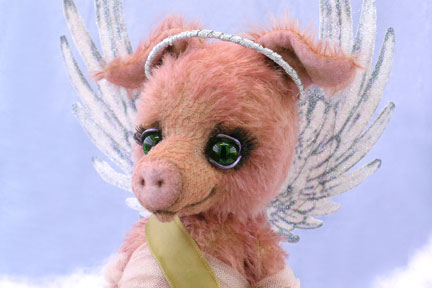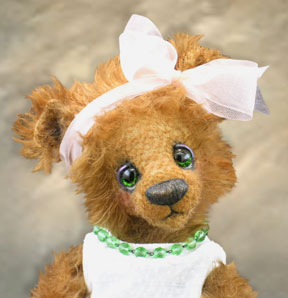For artists and collectors sponsored by Intercal...your mohair supplier and Johnna's Mohair Store
Hi,
I have been asked to make a navy blue alpaca bear. As far as I am aware, this colour won't be easy to source 'off the shelf' (however, please let me know if you do have a supplier for it - it would make my life so much easier!) so I think I may have to resort to dying my fabric, in which case I will probably use intercal's ALP4/S in white or cream, as my base material.
In view of the fact I have never dyed alpaca before, my questions are:
Will my alpaca fabric shrink in the dyeing process?
Will the pile be affected?
Is one dyeing process, more satisfactory than another?
Sorry, I know that's a lot of information I'm asking for, but I really don't want to get this wrong!! 
Paula...
My experience with dyeing fabric is somewhat limited, but I've done it about 5-10 times now and have this to offer. Here's my Level 4 (on a scale of 1-10, 1 being CLUELESS DIMWIT and 10 being VERY KNOWLEDGEABLE) summary for your review!

DYE TYPE
First it's important to know that there are different types of dye, designed for different applications.
Some of them are designed for protein-based targets... such as HAIR, which is what mohair and alpaca and wool are. Organic, animal fibers, in other words. These dyes do a really GREAT job of covering the individual hair fibers (the protein part) with color. They do a less great job of covering the fabric backing with color. So, using these kinds of dyes, you'll get rich, colorful hair... and a muted, less colorful background. I used CUSHING'S acid dye when I chose a protein dye, and I bought it right here at Intercal.
I'm having a senior moment here and can't remember the terminology used, but the other type of dye is designed for a cellulose-based target... such as cotton and linen. Plant-derived fibers, in other words. These dyes do a really GREAT job of covering the cellulose based, woven or knit fiber backing of your fabric... and a less great job of covering the hair portion. So, using these dyes, you'll get a nicely dyed fabric backing... and a muted, less richly dyed hair. I used RIT dye when I chose a cellulose dye, and I bought it at our local craft store, Michael's.
Both types of dye:
-- Will dye backing AND hair, but to varying degrees, depending on dye type
-- Will dye DARKER if you leave them on longer, or use a greater quantity of dye
-- Will dye better if you follow instructions exactly and agitate your fabric in the dye bath often
A few pics of some dyed pieces:
IN HOG HEAVEN, dyed with Cushing's acid dye (protein based) and soaked VERY briefly. Note how much richer the hair color is, than the backing color. Undyed mohair and backing color: very light cream.

BLEU, dyed with RIT. Note how much more muted and light the hair is on this one, as compared to the richness of hair color on my piggie, above. This type of dye tends to grab the fabric backing with greater interest than the hair but BLEU was left in so briefly that the backing didn't get great coverage in this particular case. Original mohair color: very light sand.

WUZZY, dyed with Cushing's acid dye, a protein dye. This one took a nice long soak in her dye bath and came out a wonderfully rich chocolate color, very deep and even. Original mohair color: very light cream.

SHRINKAGE
Yes, your fabric will shrink a little, and shift proportions, with the edges being less "squared off" due to the washing, agitating process. But your "loss", if anything, will be minimal, if you wash and dry (or air dry) in cold where possible. I always, always, always, dye BEFORE cutting. Better safe than sorry!
Your pile will also change a bit. The washing process tends to soften it and mute out any patterns or swirls. For alpaca, which is straight and thick, I think your outcome would be almost unnoticeable. It's really the curly, patterned swirls which get "lost" in the dye process. Straighter mohairs stand up to it very nicely indeed and actually come out even fluffier and softer than before, which for a big alpaca critter, might be wonderful!
Judi has dyed alpaca, I believe for Sherwood... so hopefully she'll be home soon to add some more ideas.
Hope this helps a little, Paula! Good luck!
Great info - thanks Shelli! Those gorgeous pics are a really helpful guide. 
I know so little about hand dyed fabrics and had no idea about the different types, it makes good sense to me when you talk about dyes in terms of hair colourants! Now I understand more clearly!!
So, if my understanding is right, I now need to source a protein based navy blue dye which will give me a good strong colour for the hair. I like the idea that the backing will be less vibrant as it will give lovely contrast when I scissor sculpt the muzzle!
Now I just need to find out about shrinkage, pile and the different dyeing techniques .. ie., hot water versus cold water etc, do I need to add anything to help 'set' the dye ... that kind of thing! Anyone fancy giving me a little further direction please? 
I tend to follow directions precisely and you will find them on the packaging; they will tell you hot v. cold water, etc.. Some dyes do require vinegar to set and others want you to (preferably) do your dyeing in the washing machine because it agitates so nicely and regularly. I've done that, with great trepidation!, and it actually works out just fine, much better than stirring a huge hunk of fabric in a pot ... there's no residue left behind in the machine. But I always do an "empty wash" with bleach just in case, to get any wee color molecules out BEFORE I wash my whites!
I'm still new to dying and don't know nearly everything, so, like you, Paula, I'd also be very curious about how people dye using "customized" directions... meaning, in ways that don't follow the rule-book on the back of the packaging.
I know Judi and Amy Thornton do a lot of dyeing and I'm sure many other people -- in fact we've discussed this here a number of times -- and Donna Mettling had some good suggestions a while back as well.
Hi Paula,
I don't know anything about dying mohair or alpaca as I haven't been brave enough to try it yet but a while back I found the woodland teddies website by Rita Harwood and she supplies dyes that don't need setting and it gives you information to help you too.I hope this helps.
Laurie :hug:
Dying alpaca is basically the same as dying mohair. The package directions will give you great results. I would begin with the white alpaca rather than cream simply because a cream base can sometimes change the resulting color a bit. The dye from Intercal is a great product. I don't know that you will find anything better. Hope I have helped.
Nina, I'll make sure to use the white ... I don't want to over complicate my life! Thank you for the tip!
I'm going to check out the intercal dye now and of course (banging my forehead with the flat of my hand in a 'doh' moment here Laurie!) take a look at Rita's Woodland Teddies site. Why didn't I think of that before??? !!! :redface:
Hi Paula,
I am perhaps too late, but here goes I buy the small tins of dylon dye and have a very large pan actually my old pressure cooker with out the lid! Completely wet the mohair before putting it in the pan,. Fill the pan with water boil the water up then put the dye in and loads of salt. The salt fixes the dye, then put the mohair in agitating it to get a good even coverage then simmer for a very short while or the mohair will go all matted and useless then turn the heat off all together. Leave the dye to cool down, then put the mohair in a smalls laundry bag. Put it on the rinse and spin cycle of your washing machine with a little fabric conditioner. When it comes out brush it with a soft hairbrush so the pile is going in the right direction and hope fully you will have lovely navy alpaca. Don’t cut the pieces out first as it will shrink and fray it a fat quarter normally shrinks about an inch all round.
Hope this helps hugs Kerren